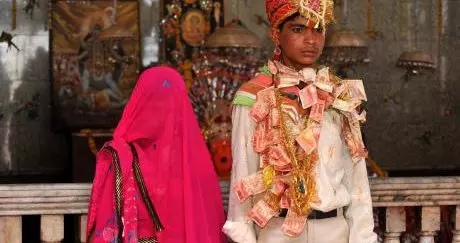
India's long overdue Uniform Civil Code, a set of common personal laws for all citizens, guaranteed by its constitution, is under renewed debate. It should not be based on Hindu law.
As we in India enter the debate on the enactment of a Uniform Civil Code (UCC), seventy years after it was guaranteed by the constitution, there is a view that the codified Hindu law should form its base.
Despite the compromises and loopholes in Hindu law which militate against gender equality, the misconception that Hindus have forsaken their personal laws and have embraced a secular, egalitarian, and gender-just code, which must now be extended to minority communities to liberate 'their' women persists.
There is also a parallel view that the best elements from all personal laws must be incorporated into this ideal code. Tested against this formulation, how will the Hindu Law, which is applicable to the mainstream majority, fare?
There is a long history of the way in which Hindu law, occasionally reinforced by colonial law, has been applied by the Indian court system against the best interests of women. We also need to take the social context into account in which other vital indicators of gender justice interact with Hindu law.
As per the recently released census data, India has 12 million married children under the age of ten, more than the population of Rwanda. The most unexpected part of the report is that 84 per cent of these were Hindus, while 11 per cent were Muslims.
Whilst these figures are roughly in proportion to the size of each community, with Hindus at nearly 80 per cent and Muslims at 14 per cent of the population, the figures are surprising because the minimum age of marriage for a Hindu girl is 18 as per the Child Marriage Prohibition Act, 2006, as well as the Hindu Marriage Act, while the principle applicable under Muslim law is 'age of reason' which is deemed to be achieved upon puberty.
Yet the figures for child marriage do not reflect a social transformation taking place due to the codification of Hindu law. Though child marriage is prohibited it is not void.
 Newly wed Mamta Bai, 12, and her husband Bablu, 14, at a temple in Rajgarh. Credit: PA Images / Prakash Hatvalne
Newly wed Mamta Bai, 12, and her husband Bablu, 14, at a temple in Rajgarh. Credit: PA Images / Prakash Hatvalne
Some groups have been campaigning for a total ban on child marriage and for declaring all child marriages void. From the point of view of social justice, what will be the impact on young Hindu girls who are married upon reaching puberty and are deserted even before they become majors?
When a destitute girl with a child in arms approaches our courts, would it be in the interest of justice to declare, since the marriage is void, that she is not entitled to her basic and fundamental right of maintenance? While this is a legal concern, there is also a social aspect to it.
The belief that a girl should be married before reaching puberty is still dominant among various rural Hindu communities. The concept of a virgin bride prevails and the fear of sexual assault which will taint the girl and render her impure and unfit for marriage still persists and the parents are afraid to take the risk of keeping an unmarried girl at home.
The fear of the girl eloping with a boy of her choice and bringing dishonour to the family also haunts parents due to which parents prefer to marry off their daughters young. This exposes the young vulnerable girl to sexual and domestic abuse in her marital home.
It also results in early pregnancy which is one of the main causes of maternal mortality in our country. Yet the fear of sexual purity and sexual defilement overrides concerns for the girl's health and security while marrying off an underage daughter.
The reformed Hindu law has not been able to bring about a change in this deeply ingrained notion.
It is not a question of criminalising child marriage and declaring it void; adequate facilities for education, both formal and informal, skills training, a secure environment for a young girl to grow up until she reaches the age of 18, along with a change in the parental mind-set regarding the notion of the virgin bride are some of the measures which are needed.
A Hindu father still believes that marrying his daughter is a pious obligation which he must perform to attain salvation. Apart from encouraging child marriage, this concept also gives a boost to the dowry system, despite our laws criminalising dowry and dowry-related violence.
The pressure to marry off their daughter, at any cost, drives parents to meet the dowry demands of the groom's family rather than bear the stigma of having an unmarried daughter. Despite the legislative reforms to curb dowry deaths and suicides, the figures are constantly rising.
In an informal study of dowry deaths which reached the Supreme Court and the Bombay High Court, conducted by Majlis, Mumbai, over 95 per cent of these cases of dowry death were among Hindus.
While the system of dowry has spread to lower castes and minority communities, its roots in Hindu cultural tradition cannot be overlooked. Ironically, Muslim law started with the more progressive notion of mehr, an amount which must be stipulated in the marriage contract as a future security to the bride.
Unfortunately, the community has accepted the anti-women Hindu custom of dowry, while mehr amounts have been reduced to a mere token.
The age-old dictum still prevails that a girl who enters a bridal home in a wedding procession must leave the home only in a funeral procession. So despite acute domestic violence girls are sent back to their marital homes even at the risk of them being killed or driven to suicide.
Despite amendments to the Hindu laws which rendered the Hindu marriage contractual, the sacramental aspect still dominates the social psyche and parents prefer to send the daughter back to her matrimonial home rather than risk having a divorcee on their hands.
In contrast, a Muslim marriage is always regarded as a civil contract. While the Christian marriage started on the premise of a permanent and indissoluble sacrament, gradually due to education and exposure, perceptions about sacramental marriage have changed.
While among the urban, middle and upper classes Hindus, divorce is gradually gaining acceptance and there is greater likelihood of women opting for divorce when faced with domestic violence, in rural areas where conservative views of sacramental marriage still dominate women are less likely to opt for divorce even when faced with cruelty, desertion or their husband's adultery.
The concept of permanency of marriage and husband as the Lord and Master, still dominates not only our public life, but also litigation in family courts where women are constantly advised to return to save their marriage even at great risk to themselves, as the judges themselves endorse this view.
Women believe that even if their husbands are abusive, violent or alcoholic they prefer to remain married, since the marriage symbols which are worn by married women, like the black beads round the neck and sindoor (red powder) on their forehead, are perceived as marks of respect, status and protection against advances from other men.
Despite the enactment of PWDVA (The Protection of Women from Domestic Violence Act 2005) , the only advice given to most women either by the police or social workers situated in police stations, is to reconcile in order to save her marriage and return to her matrimonial home.
This appears to be the most viable solution as the state has not attempted to evolve alternate support structures to help women to make the transition from a housewife to an independent and self-supporting person.
When there is a resumption of violence, the women are in a state of acute depression. A recent international study which covered 187 nations revealed another disturbing fact that suicide is the leading cause of death among married women, aged from 15-49 in India, replacing death due to maternal disorders.
An overwhelming number of these are likely to be urban Hindu housewives. While all religions are patriarchal and believe in maintaining a strict control over a woman's sexuality, the hold of Brahminical patriarchy reaches a high pitch when we examine the phenomenon referred to as honour killings where a girl is brutally killed by her own parents or at their instance, for transgressing the caste boundaries, and marrying a man/boy from the lower castes.
Earlier this phenomenon was believed to be prevalent only in North India, but now several Southern states have also started reporting these occurrences at regular frequency. The young couple is also killed for contracting sagotra (same lineage i.e. inbreeding) and sapinda (cousin) marriages within certain North Indian communities.
Against this overarching evidence of anti-women social practices, can we assume, un-problematically, that the codified Hindu law has been instrumental in bringing social transformation and changed gender relationships and provided the necessary foundation upon which a strong edifice of a uniform and gender just family code for India can be built? This is the challenging question that confronts us today.
This article is adapted from the 2016 Durgabai Deshmukh Memorial Lecture delivered by Flavia Agnes and was republished from OpenDemocracy.net